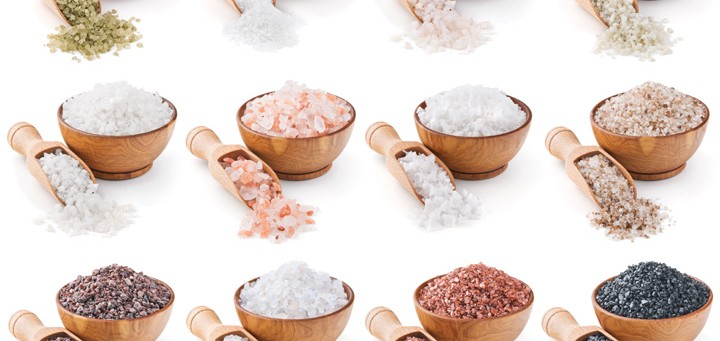
Truly Deeply Madly
May We Suggest … Salty Goodness
October, 2015
Salt. What we toss nonchalantly over shoulders today was once so precious it financed the Great Wall of China. And though it’s no longer worth its weight in gold, our cravings for it are still mighty. To help you decipher which types to use when, here’s a taste of what you will find.
Table Salt—A.k.a that blue-and-white box with the pullout metal spout. This is the all-purpose salt a lot of us grew up with.
Origins: Underground salt deposits are dissolved, mechanically evaporated and purified for culinary use.
Taste, Texture & Character: The fine-grained, cube-shaped crystals dissolve uniformly in your mouth.
Mineral Content: Sodium chloride with a bit of potassium iodide to keep it free-flowing.
Best for: Everyday baking and cooking.
Fun Fact: Both salt brands, Sifto and Windsor, mine salt in Ontario, near (and 1800 ft. under) Lake Huron.
Kosher Salt—A coarse salt certified as pure, meaning pure sodium chloride (additive-free).
Origin: Specifically designed for “koshering,” or salting meat to draw out the blood.
Taste, Texture & Character: Its coarse-textured large crystals are ideal for picking up with your fingertips and sprinkling evenly over food when you’re preparing it. It’s not a finishing salt.
Mineral content: Pure sodium chloride.
Best for: Pickling and salting foods, but is also a great for salting a margarita glass or salt-crusting a whole fish.
Fun Fact: Packaged salt that features a kosher-approved symbol is certified to be pure.
Sea Salt—Salt harvested from the sea, of course.
Origin: Ocean salt water is evaporated by the sun and wind, producing a salt “crop.”
Taste, Texture & Character: This salt varies widely in grain size and subtle flavours. If you’re looking to replace your table salt, choose a sea salt labelled “fine.”
Mineral content: Sodium chloride and trace minerals (including iron) that reflect the composition of the sea water.
Best for: Meat, fish, potatoes, vegetables—basically anything you’d normally use table salt to season.
Fun Fact: Only 2.7% of the ocean is salt.
Fleur de Sel—A luxury sea salt best thought of as a garnish or a condiment.
Origin: The thin layer of salt that rises to the surface of shallow pools of sea water is laboriously hand-raked and solar evaporated.
Taste, Texture & Character: The irregular, moist crystals make this salt dissolve quickly, almost melting in your mouth. The flavour profiles differ vastly from region to region and from country to country (France, Mexico, Italy).
Mineral content: Sodium chloride plus trace minerals from the environment from which it’s harvested.
Best for: Steamed vegetables, pan-fried eggs, and grilled steak. Try a light sprinkling on chocolate chip cookies before they go in the oven—astounding!
Fun Fact: Classic fleur de sel is produced in Guérande, Camargue, Noirmoutier and I’ile de Ré. But the label “fleur de sel” describes the way the salt is made and the qualities it possesses.
Sour Salt—Also known as citric acid, a natural acid found in citrus (especially lemons and limes).
Origin: It was first isolated from lemon juice by Carl Wilhelm Scheele in 1784.
Taste, Texture & Character: Fine white crystals with dynamite sourness. It’s often used to enhance lemon and lime flavours in recipes and to give sourdough its trademark tang.
Mineral content: Sour salt contains no sodium.
Best for: It’s a classic addition to borscht (beet soup), and a pinch added to a bowl of water will keep freshly cut fruit from browning.
Fun Fact: Citric acid is sometimes added to sausages to keep them pink.
Himalayan Pink—Rock salt mined from the Himalayan mountains.
Origin: This salt has been quarried by hand in the Himalayas for millennia and is readily available in most grocery stores (and box stores with kitchen sections).
Taste, Texture & Character: It varies in colour from blood-red to translucent snow-white. The bone-dry salt crystals resemble rosy-hued tumbled pebbles. You can also buy fine-grained versions.
Mineral content: 97% sodium chloride and considered one of the purest salts on the planet. It is also widely touted for containing 84 trace minerals (such as phosphorous, zink and bromine), but the buzz about its health benefits are yet to be proven.
Best for: Use on roasted game, bison or any application where complete dissolution of salt is desired (pasta water, tomato sauce or other sauces).
Fun Fact: The pink colour comes from its trace amounts of iron oxide.
Did You Know?
In 1924, the Michigan Medical Association requested the Morton Salt Company add iodine to their table salt to battle iodine deficiency.
Grey salt harvested in the Guérande gets its colour from the clay-lined marshes from which it’s collected.
Photo, © andriigorulko / Dollarphotoclub












